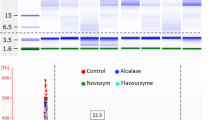Abstract
Formation of lysinoalanine (LAL) in proteins in response to alkali treatment is a well-known phenomenon. The quantity of LAL formed depends on temperature, the time of exposure to alkali, the type of protein, the concentration of protein and alkali in some instances, and probably the type of cation in the alkaline solution. Higher temperatures, longer exposure times, and higher pH’s generally result in more LAL formation. The addition of mercaptoethanol or cysteine to an alkaline protein solution decreases LAL formation markedly; lanthionine is apparently a major product formed when cysteine is added to an alkaline protein solution. Some LAL is likely to be formed in any protein-containing product that is subjected to alkaline treatment, and has been shown to be formed in some protein products under extreme heat conditions. Proper control of temperature and pH in processing can reduce or eliminate LAL formation. LAL has not been shown to present a toxicological hazard to any species other than the rat. Its presence in large quantities in any protein indicates destruction of cysteine and lysine; the nutritional inferiority of severely alkali- or heat-treated proteins due to LAL formation, amino acid degradation and isomerization, Maillard product formation, and so on is well documented. The small quantities of dietary LAL in food products currently on the market seem to represent no health hazard; the reduced nutritional quality of protein products that contain relatively high levels of LAL should be considered when these products are major sources of dietary protein.
Similar content being viewed by others
References
Walsh, R.G., A.S. Nashef and R.E. Feeney, Int. J. Peptide Protein Res. 14:290 (1979).
Bohak, Z. J. Biol. Chem. 239:2878 (1964).
DeGroot, A.P., P. Slump, L. Van Beek and V.J. Feron, in “Evaluation of Protein for Humans,” edited by C.E. Bodwell, AVI, Westport, 1977, pp. 270–283.
DeRham, O., P. Van de Revaart, E. Bujard, F. Mottu and J. Hidalgo, Cereal Chem. 54:238 (1977).
Hasegawa, K., and N. Okamoto, Agric. Biol. Chem. 44:649 (1980).
Provansal, M.M.P., J.-L.A. Cuq and J.-C. Cheftel, J. Agric. Food Chem. 23:938 (1975).
Hayashi, R., and I. Kameda, Agric. Biol. Chem. 44:175 (1980).
Karayiannis, N.I., J.T. MacGregor and L.F. Bjeldanes, Food Cosmet. Toxicol. 17:585 (1979).
Creamer, L.K., and A.R. Matheson, J. Dairy Sci. Technol., N. 2, 12:253 (1977).
Sternberg, M.M., C.Y. Kim and F.J. Schwende, Science 190:992 (1975).
Aymard, C., J.-L. Cuq and J.-C. Cheftel, Food Chem. 3:1 (1978).
Struthers, B.J., R.R. Dahlgren, D.T. Hopkins and M.L. Raymond, in “Soy Protein and Human Nutrition,” edited by H. Wilcke, D.T. Hopkins and D.H. Waggle, 1979, pp. 235–260.
Raymond, M.L., J. Food Sci. 45:56 (1980).
Finley, J.W., J.T. Snow, P.H. Johnston and M. Friedman, Adv. Exp. Biol. Med. 86 B:85 (1977).
Chu, N.T., P.L. Pellett and W.W. Nawar, Agric. Food Chem. 24: 1084 (1976).
Sanderson, J., J.S. Wall, G.L. Donaldson and J.F. Cavins, Cereal Chem. 55:204 (1978).
Karayiannis, N.I., J.T. MacGregor and L.F. Bjeldanes. Food Cosmet. Toxicol. 17:591 (1979).
Struthers, B.J., R.R. Dahlgren and D.T. Hopkins, J. Nutr. 107:1190 (1977).
DeGroot, A.P., P. Slump, V.J. Feron and L. Van Beek. Ibid. 106:1527 (1976).
Van Beek, L., V.J. Feron and A.P. DeGroot, Ibid. 104:1630 (1974).
Struthers, B.J., D.T. Hopkins, E.E. Prescher and R.R. Dahlgren, Ibid. 108:954 (1978).
Author information
Authors and Affiliations
Additional information
All values of LAL have been converted to ppm for purposes of comparison in this review. The alkali concentrations in another paper were likewise converted, from moles/kg to molarity (14). Some of the LAL values were estimated from graphs and are only approximate (7).
About this article
Cite this article
Struthers, B.J. Lysinoalanine: Production, significance and control in preparation and use of soya and other food proteins. J Am Oil Chem Soc 58, 501–503 (1981). https://doi.org/10.1007/BF02582413
Issue Date:
DOI: https://doi.org/10.1007/BF02582413




